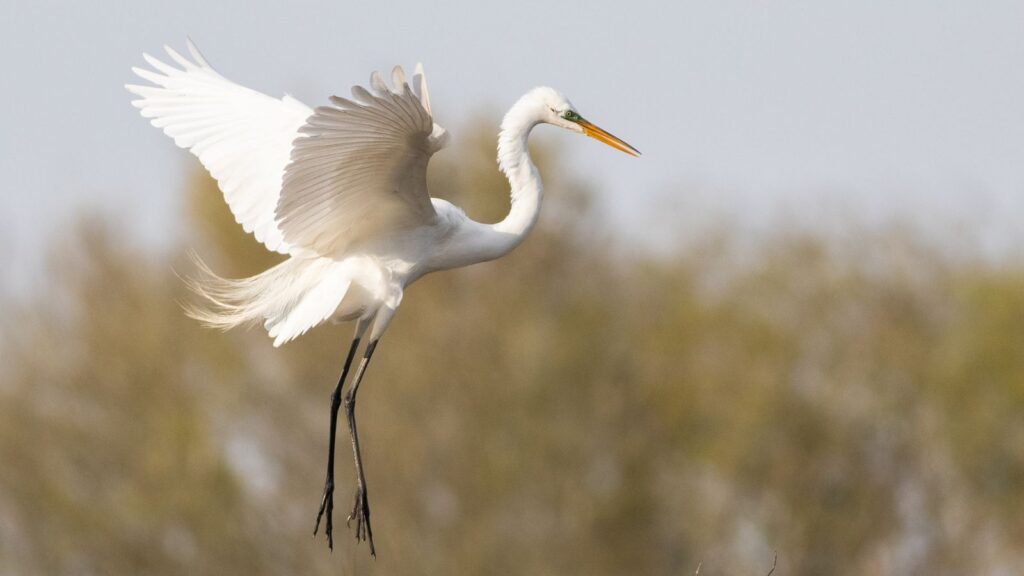If you’ve been out birdwatching and spotted a bird with long legs, you might be wondering which one you saw. There are so many birds with long legs in North America that accurate identification can be a tricky business.
Of the many long-legged birds in North America, herons, cranes, ibises, sandpipers, and storks are but a few of the families.
We don’t have the space here to describe every long-legged bird in North America, so instead we’ve listed some of the most fascinating species from the main families of birds with long legs.
While some of them are easy at Pi to identify, others take more practice – so pay close attention to the identification tips coming up!
14 North American Birds With Long Legs
American Flamingo
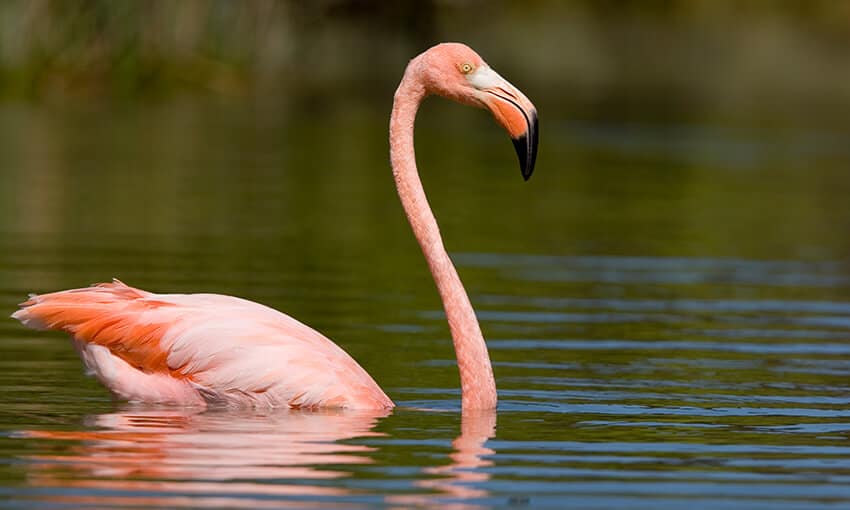
Why not start our list with the bird that has the longest legs of them all? American flamingos are extraordinarily tall birds that can sometimes reach 59 inches in height – yes, one inch short of five feet. Its legs measure more than half of its height, and are longer than its body!
American flamingos are sometimes known as Caribbean flamingos because they’re mostly seen in the Caribbean islands. They’re only occasional visitors to the USA, and when they do visit, it’s nearly always in Southern Florida.
American flamingos are the brightest-colored flamingos in the world. Their iconic crooked bill is used to filter feed algae and plankton from the water. Because their young can’t feed this way, the parents produce a fluid in their throat that’s very similar to mammal milk to feed them.
This has to be seen to be believed!
Black-necked Stilt
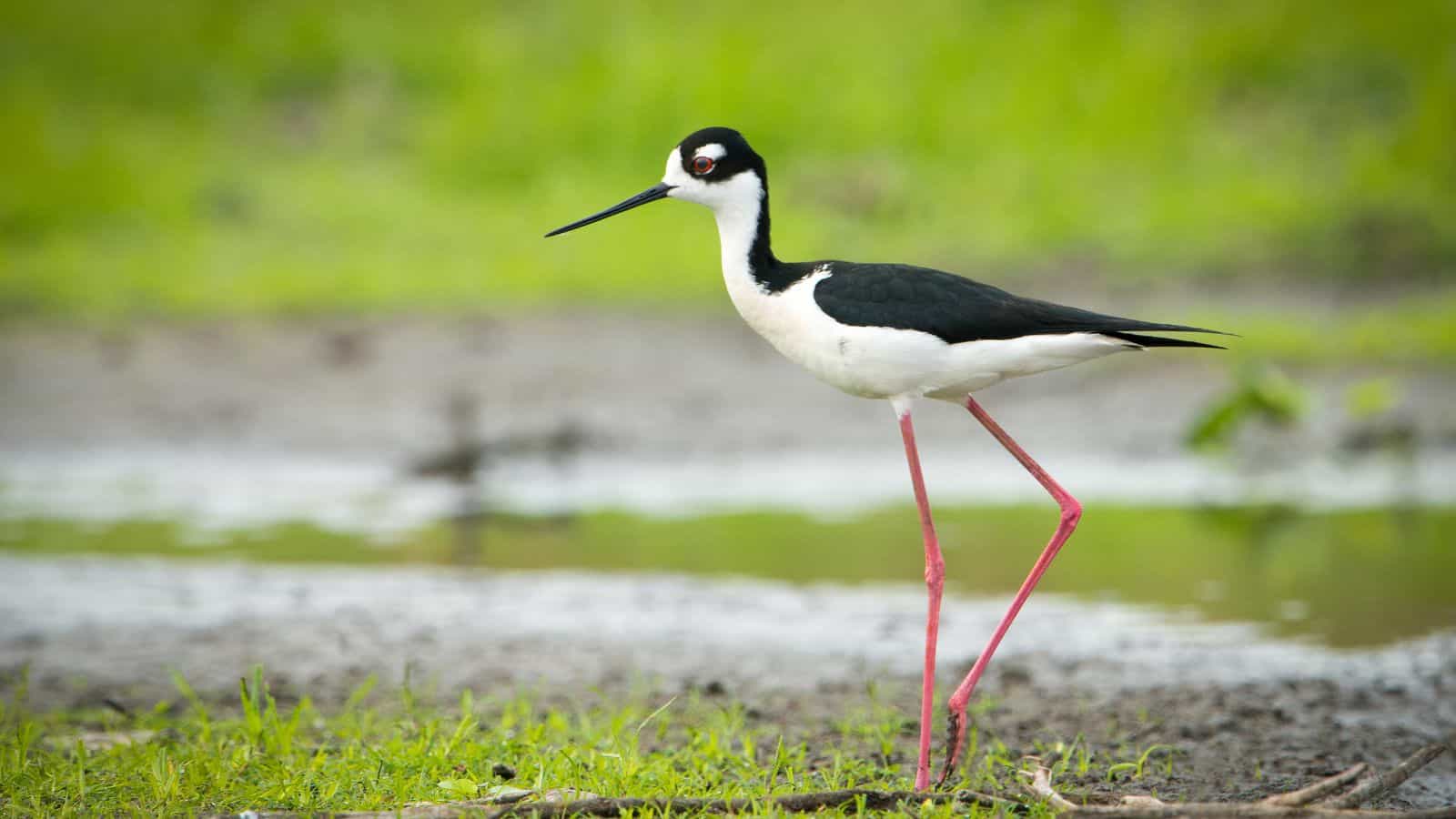
If there’s one bird that has even more absurdly long legs in proportion to its body than the flamingo, it’s the black-necked stilt.
Unlike flamingos, black-necked stilts are widespread across North America, but usually only in places that harbor their favorite habitat of still ponds with muddy bottoms.
Pretty birds, their elegant long red legs are matched only by their bright red eyes. The rest of their body is black and white.
Like most wading birds, black-necked stilts have a long bill that they use to pluck shrimp, insects, worms, and small fish from the mud. This species prefers to build their nests on the edges of shallow, weedy ponds where they’ll be guaranteed a good food supply for their young.
Whooping Crane
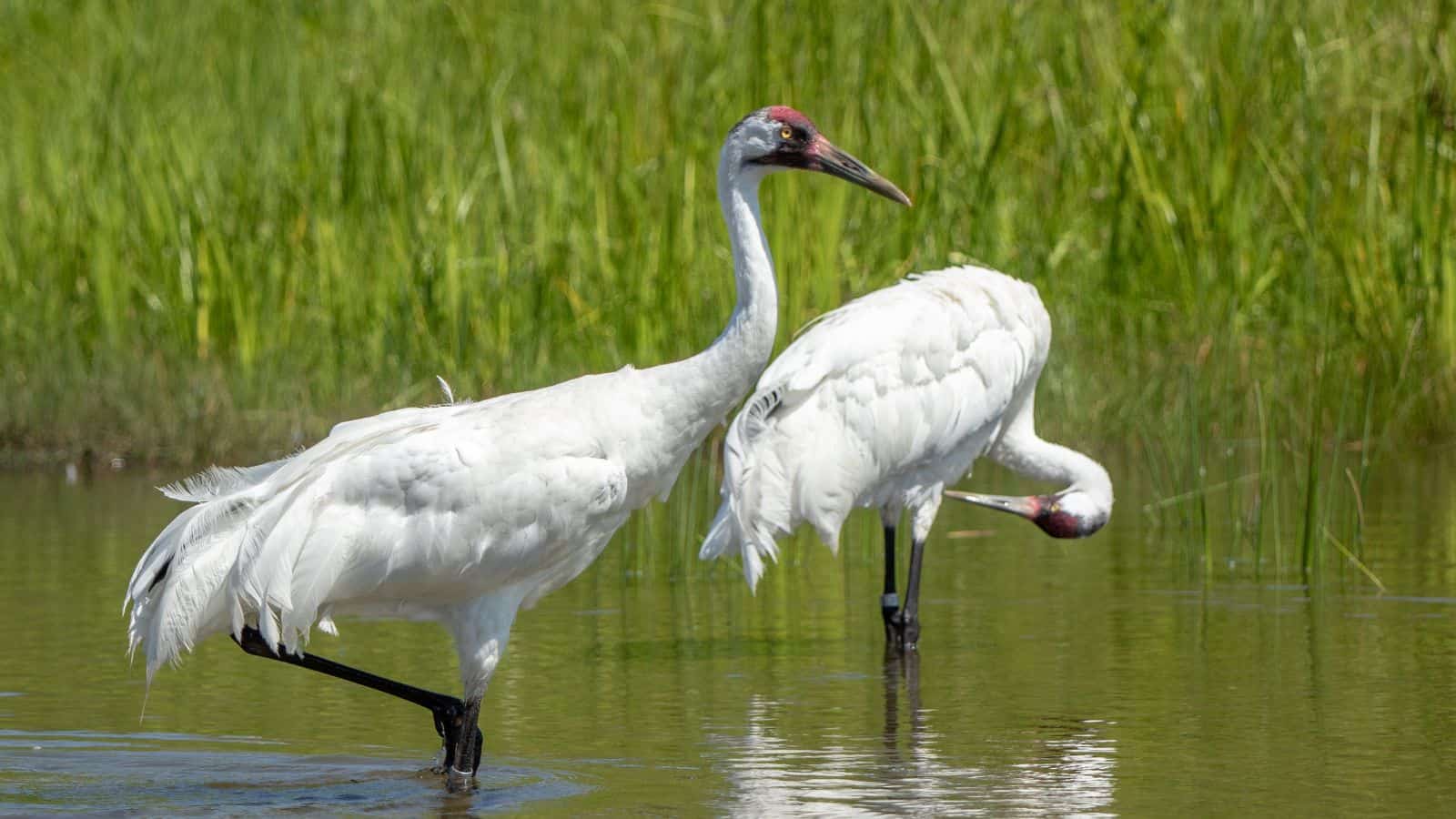
Standing just slightly taller than the American flamingo, the whooping crane is officially the tallest bird in North America. At around five feet high and weighing 15lb, these impressive birds are also in the top 5 heaviest birds in North America.
With their elegant shape, all-white feathers, and red face, whooping cranes are a treat to behold. Sadly, they’re also one of America’s rarest birds. Due to habitat loss, there were only 60 individuals left in the wild by the 1970s.
Thankfully, conservation and reintroduction methods have been partially successful, and whooping cranes numbered 536 when US Fish and Wildlife Services made their last survey in 2022-2023.
Whooping cranes have an extraordinarily confined migratory range. The main population overwinters exclusively in Aransas National Wildlife Refuge in Texas, before flying 2,500 miles to their breeding grounds in Wood Buffalo National Park in Canada.
If you live anywhere between those two sites, you can look out for them along the way!
Great Blue Heron
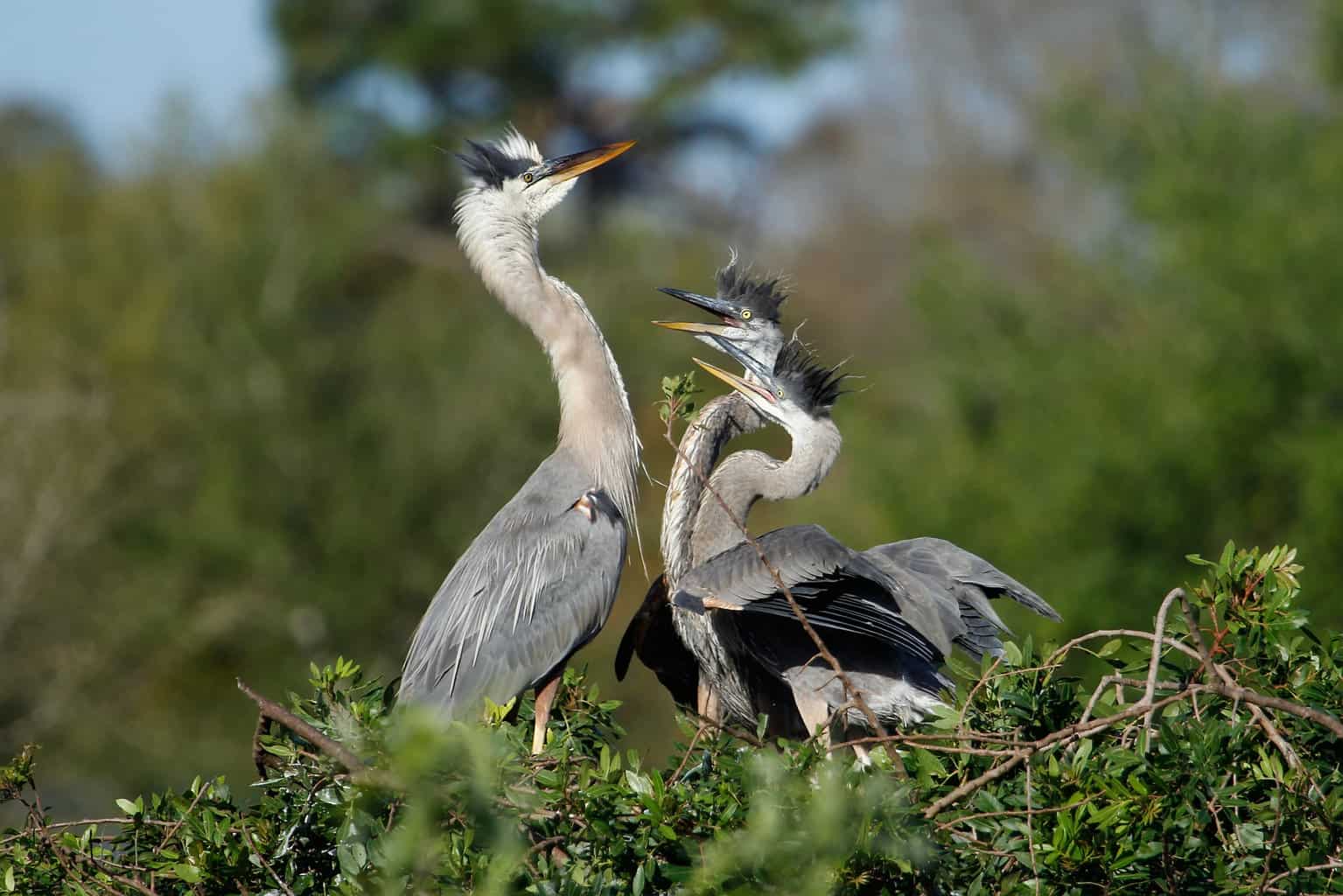
A list of long-legged birds wouldn’t be complete without at least one heron. The great blue heron is the largest and heaviest heron in North America and is also one of the most widespread.
Their enormous 72-inch wingspan, yellow bill, and black plumes at the back of their head make them easy to recognize.
Great blue herons are usually fairly solitary birds but nest in colonies among trees standing in water and also flock together during migration. This powerful predator uses its long legs to wade into shallow water, then unleashing its dagger-like bill, it can spear fish up to 2 feet long!
Other prey items include frogs, shrimp, and crayfish, but the adaptable great blue heron will also sometimes hunt on land. Snakes, lizards, turtles, rats, ground squirrels, and small birds are also on the menu!
A white color morph of the great blue heron is common in Florida. A bit like an enormous egret, this morph tends to be around 10 percent larger than the regular great blues.
Listen out for the great blue heron’s grunting call as they pass overhead.
Northern Jacana

Northern jacanas might be very rare birds north of Mexico, but we couldn’t resist including them because of their extraordinary legs! Not only are the legs very long, but they also have the longest toes of any bird in proportion to their body size in the entire world.
The absurd-looking feet allow northern jacanas to walk upon floating vegetation such as water lily pads in search of food. This surreal spectacle has led people in Jamaica to refer to the northern jacana as the ‘Jesus bird’ or ‘lily trotter’ because it appears to walk on water.
Although Northern Jacanas are more common in Central and South America, they have a patchy distribution and have been known to show up in various southerly states in the US. According to the Sibley Guide to Birds, they’ve been recorded nesting in Texas.
- Sibley Guide To Birds, 2nd Ed
- Sibley, David Allen (Author)
- English (Publication Language)
Last update on 2024-07-26 / Affiliate links / Images from Amazon Product Advertising API
Limpkin
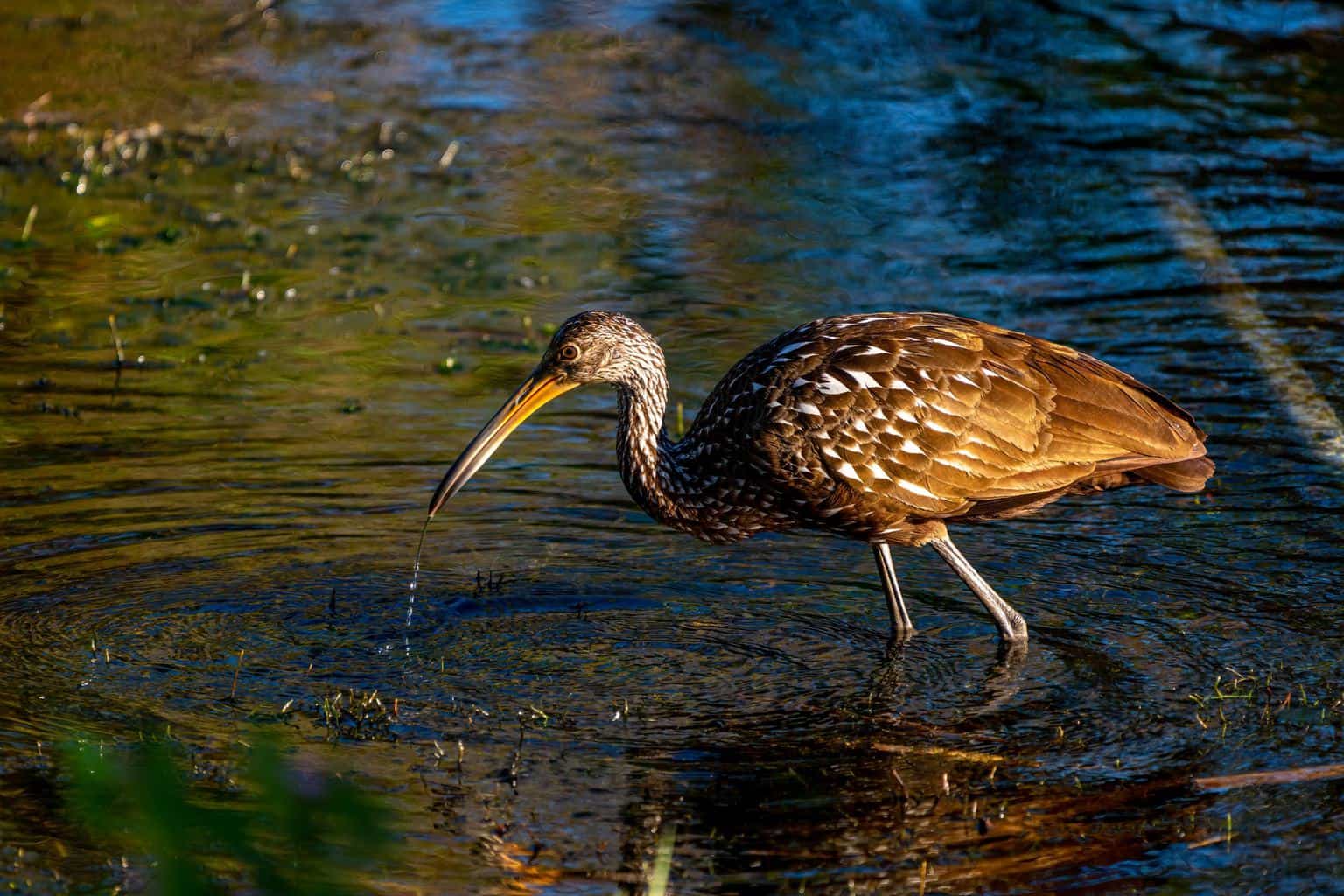
Limpkins are unusual-looking long-legged birds from the water rail and crane family. With a wingspan of 40 inches across, they’re much smaller than a sandhill crane, but much bigger than the largest king rail.
Limpkins have an upright stature much like a crane, though, and a very long, straight bill rather like a stork. Their plumage is mainly brown with white spots.
Limpkins are native only to Florida and occasionally Georgia in the USA where they can be found year-round, strolling stealthily through brushy swamps and wooded pond edges, mostly in search of mollusks.
White-faced Ibis

The white-faced ibis’s common name must cause much confusion among bird enthusiasts. Adults do indeed have some white on their faces, but it’s only a narrow band around an otherwise pinkish face. This white plumage also only appears during the breeding season!
Despite its misleading name, the white-faced ibis is a gorgeous-looking bird with a glossy, brown, and green iridescent back, brown to red legs, and a long, stout gray bill.
White-faced ibises are locally common birds in the USA, especially where there are abundant shallow pools for them to forage. In Eastern Texas and Louisiana, they may get confused with their relative the glossy ibis, especially during the winter when both species are more grayish in color.
American Avocet

Avocets are part of the large sandpiper family, but while there are three other species on other continents, the American Avocet is the only member in North America. Its long, upturned bill, black and white back, and long blue legs make this a stunning bird. During the breeding season, males develop a rich tan head and neck.
This is when you’re most likely to see them in the USA and Canada, as this migratory bird breeds in shallow lakes and ponds across the central and western states. They overwinter along the coastal fringes of Pacific and Atlantic seaboards, as well as inland in Mexico.
American avocets rest and sometimes feed together in compact flocks, sweeping their head through the water from side to side as they snap up aquatic invertebrates. Their graceful movements and endearing way of preening themselves surely make them one of the most elegant birds in America.
Greater Yellowlegs
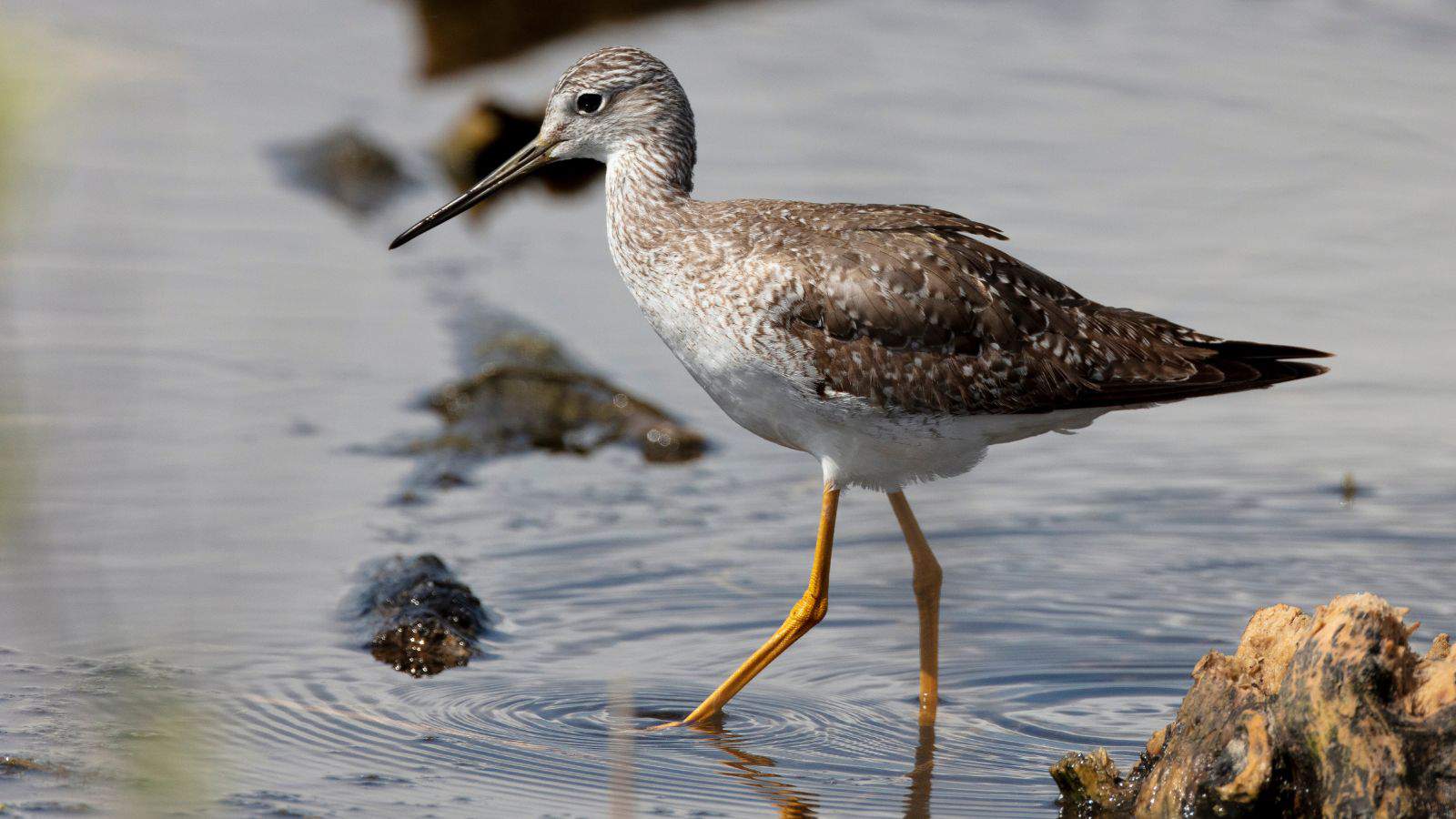
Another member of the sandpiper family is the greater yellowlegs. Along with their cousins, the lesser yellowlegs, greater yellowlegs earned their name for good reason!
Their long lemon-yellow legs and yellow feet are perfectly adapted for wading through shallow water.
While the greater yellowlegs mostly feed on invertebrates, they can also be seen chasing down small fish. Like most other waders, they’ll also take advantage of sea creatures left exposed on mudflats at low tide.
Yellowlegs are purely winter birds in the United States, where they mostly congregate along both Pacific and Atlantic coasts.
In the summer, they fly to Northern Canada to nest around shallow ponds in boreal spruce forests.
Long-billed Curlew
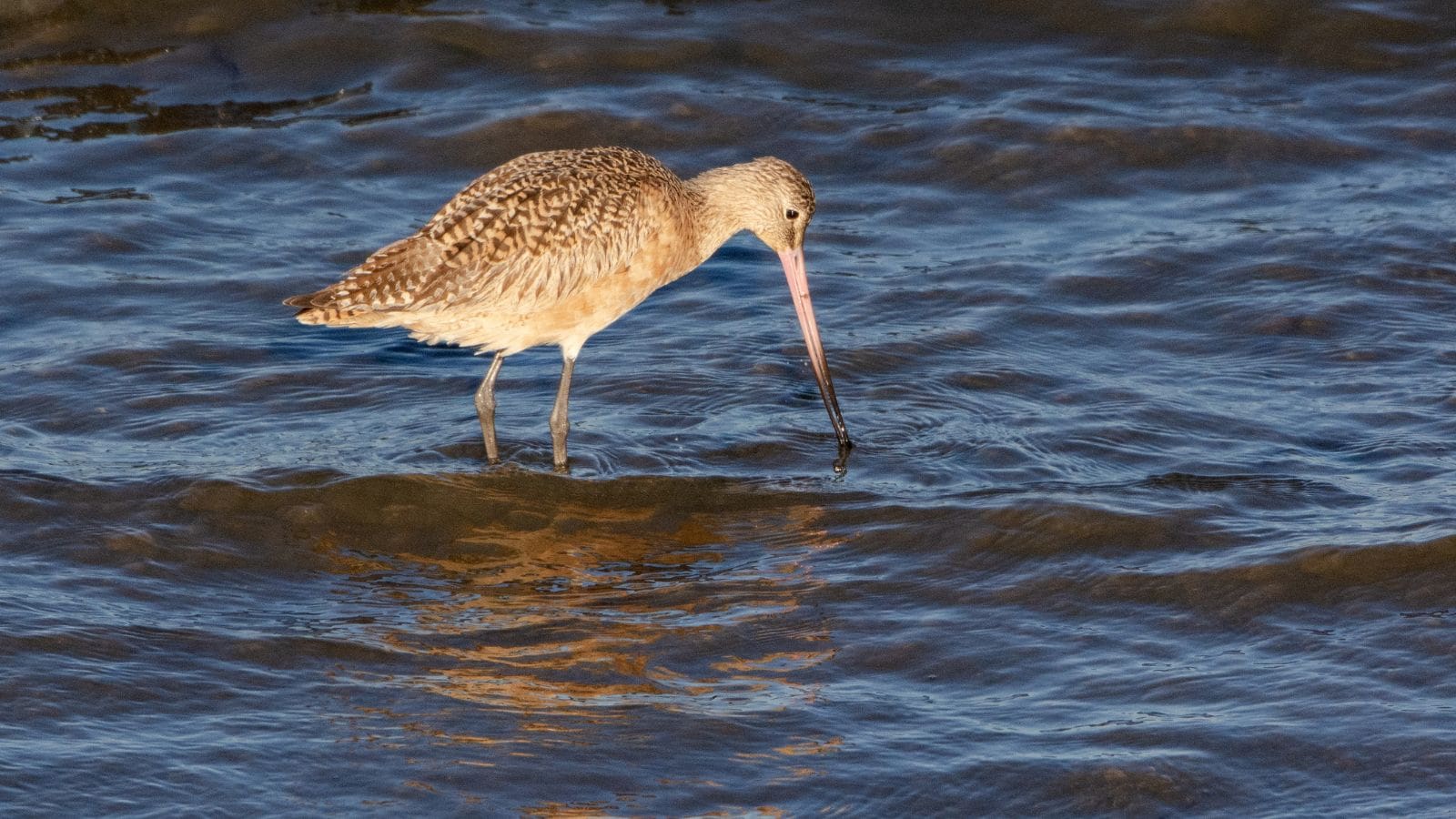
It’s interesting that many of the birds with long legs also have long bills, and the long-billed curlew certainly wins the prize in that contest!
Also known as the ‘sicklebill’ and ‘candlestick bird,’ this spectacular species has a bill that can measure nearly 9 inches long.
The long-billed curlew is the largest member of the sandpiper family in North America. With a body length of 23 inches, it dwarfs its relatives like the whimbrel and little curlew.
These are uncommon birds in North America and are mainly found in the western states, although some small populations overwinter along the east coast, as well.
Like other curlews, the long-billed curlew has a range of lovely, evocative calls and songs that carry through the lowland valleys and tidal flats that they occupy.
Wood Stork
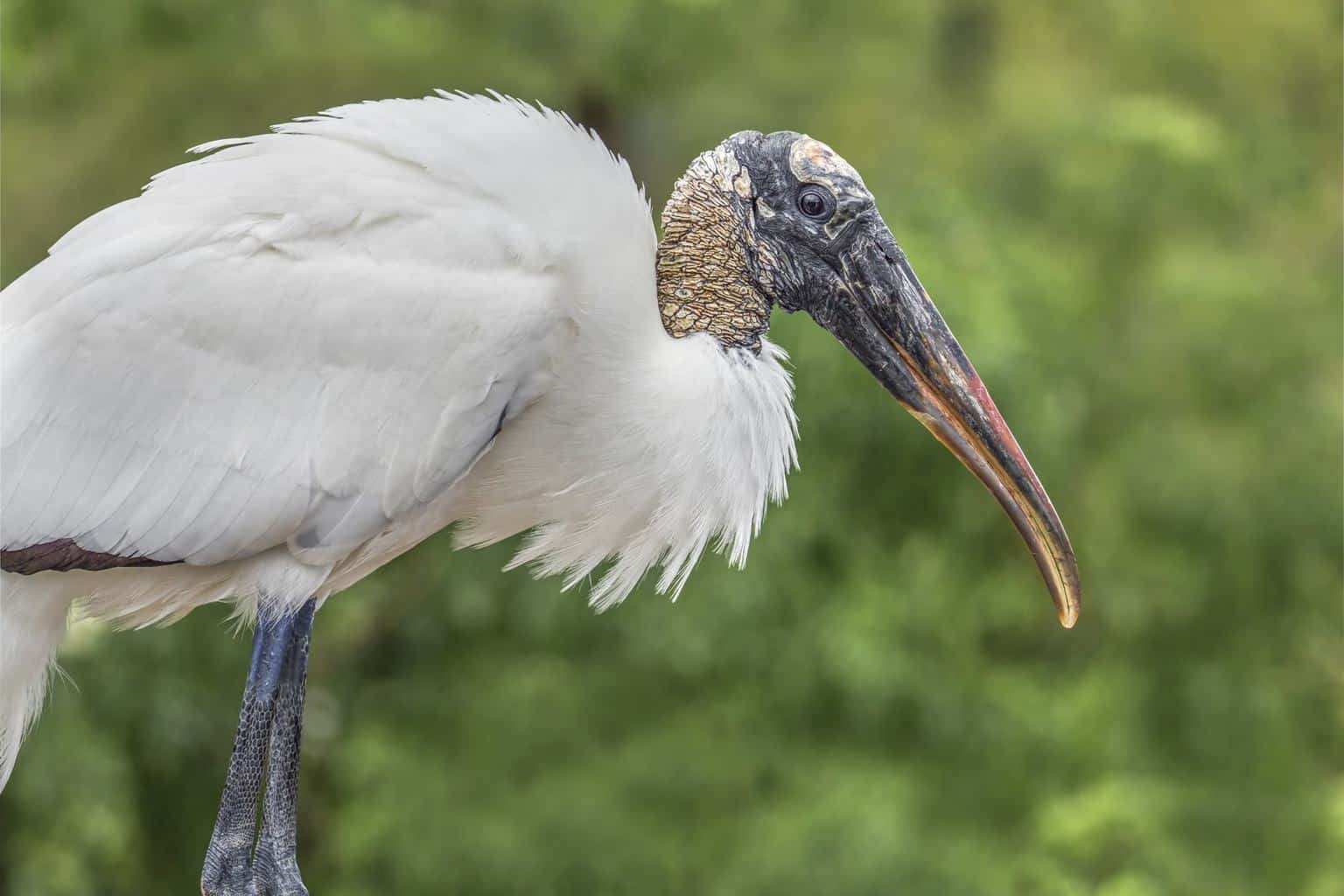
Back to a heavy-weight wading bird species now, the wood stork has a wingspan of over 5 feet across and can often weigh more than 5lb.
This vulture-like bird has a bald head and neck but doesn’t tend to scavenge on carrion. Instead, this adept hunter feeds mainly in a piscivorous fashion during dry weather when fish are more concentrated in shallow water. In wetter periods, it supplements its diet with crabs, frogs, and aquatic insects.
Wood storks are extremely widespread in South America, and locally common in Central America, but only venture into the southernmost reaches of the USA.
There is a permanent population in Florida, Georgia, and South Carolina, but they will sometimes show up in other states, too.
Great Egret
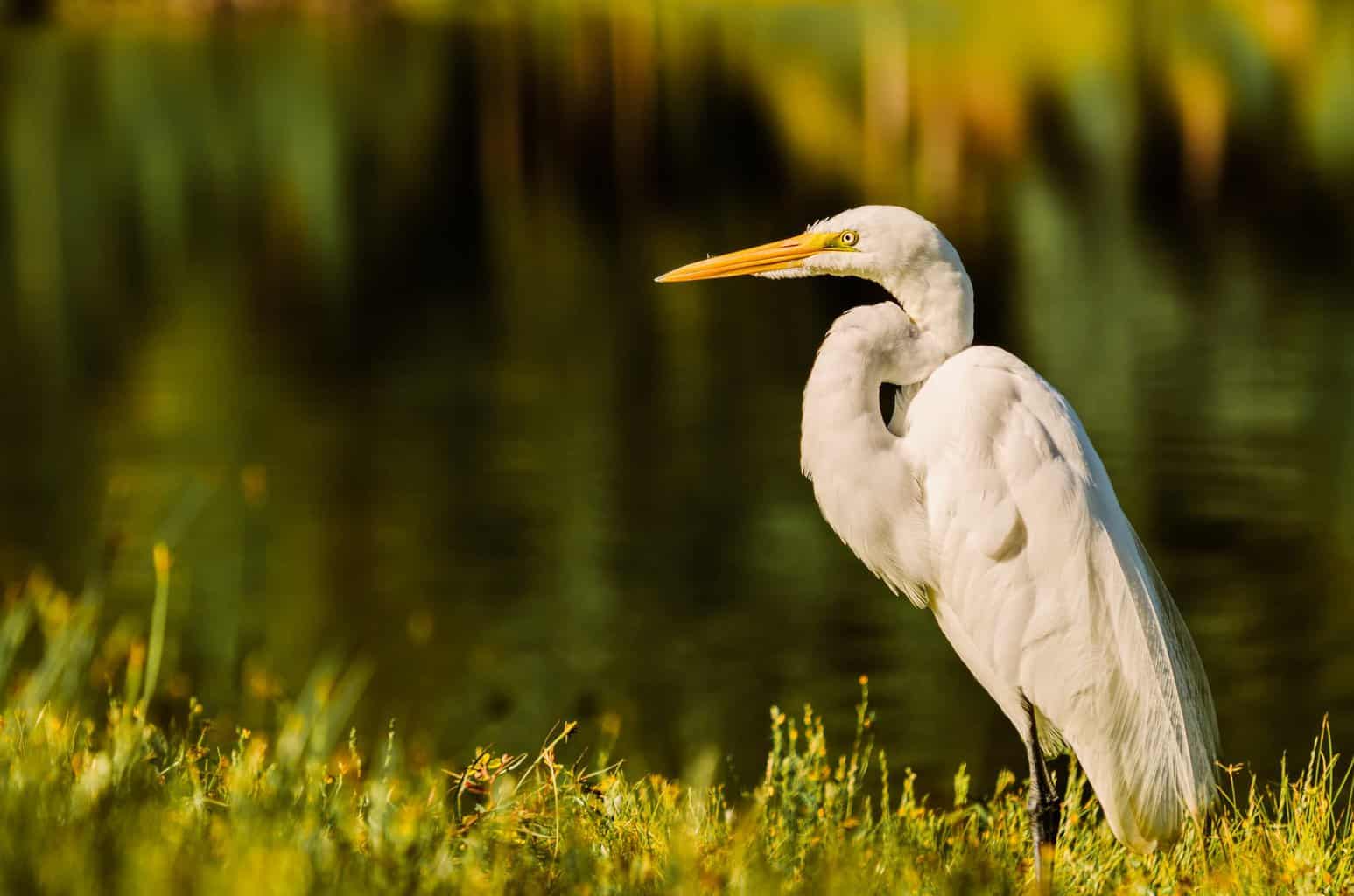
The term ‘egret’ often refers to a white-colored heron species. The great egret even belongs to the same genus as the great blue heron, but is much smaller, weighing less than a third of their huge relatives. They have yellow bills and blackish legs.
Great egrets have especially long legs for their size, which allows them to wade in deeper water. Like the great blue heron, they’ll sometimes also hunt in grassy fields for amphibians and small mammals.
Great egrets are widely distributed in the United States and can be found from Florida to Washington state. To protect their young from predators, they nest on islands or in trees standing in water.
Willet
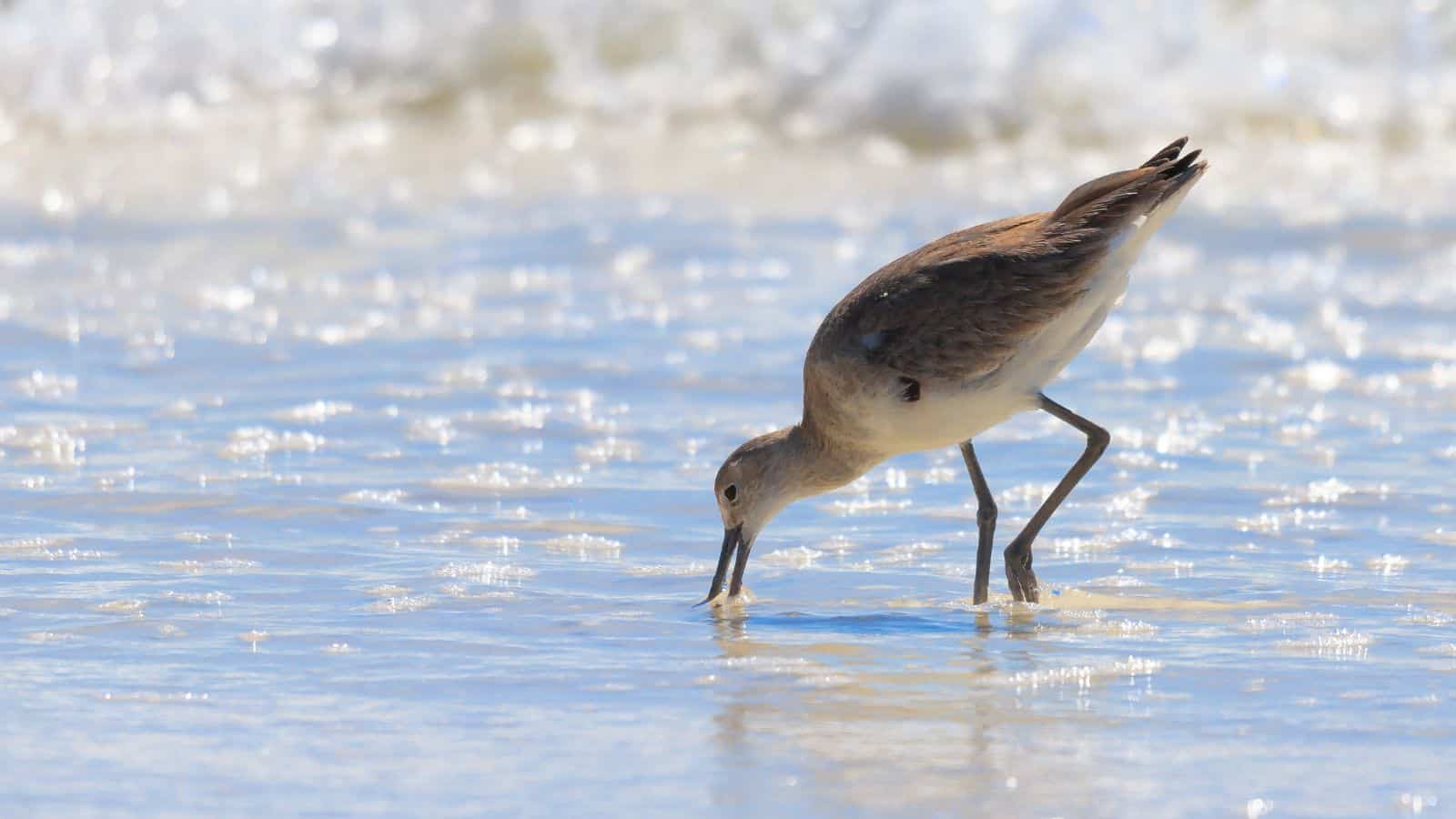
The willet is one of those birds that’s named after their song. When declaring their territory to other birds in the spring, the raspy whistling chants ‘pilly-will-willet’ ring out repeatedly over the willets’ breeding grounds.
The willet is a large, grayish wader that adopts brown-speckled plumage in the breeding season. This is particularly pronounced in the eastern subspecies, which remain along the east coast from Texas to Maine all year.
By contrast, the western subspecies overwinter by the Pacific coast but breed inland in the northwest.
Willets are often seen alone, patrolling mud flats and shallow water in search of insects, mollusks, and crustaceans to eat. When startled, they’ll often let out a high-pitched shriek, open their wings, and run, rather than fly away.
Ruff

Our last long-legged bird is also a highly prized sighting in North America. Although they’re fairly rare visitors from Eurasia, the ruff is such a remarkable bird that we had to squeeze it onto our list of birds with long legs!
Ruffs got their name from the bizarre-looking neck feathers in males that can be puffed out during courtship displays. These feathered ‘ruffs’ can be white, brown, red, black, or a mixture, and are used to impress females or intimidate rival males.
Male ruffs are famous for the fierce, sparring battles which can be seen in this beautifully shot video.
Ruffs have an extraordinarily vast migratory range that extends from Scandinavia to South Africa, and from India to Australia.
No wonder these nomadic birds sometimes end up in North America! They’ve been seen from Alaska to California in the west, and from Florida to Newfoundland in the east.

